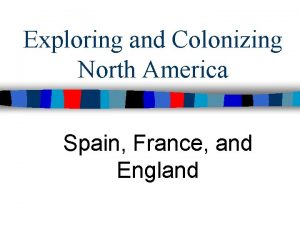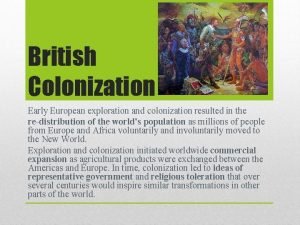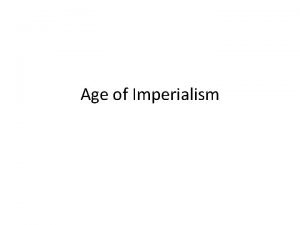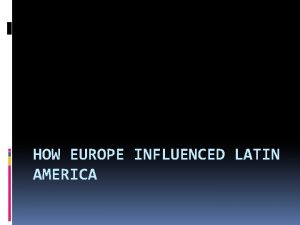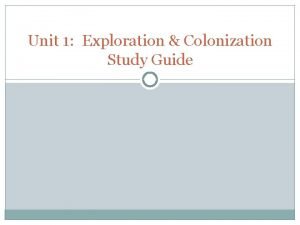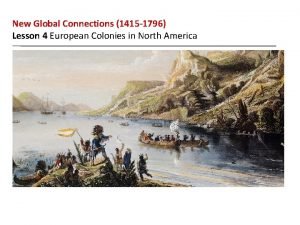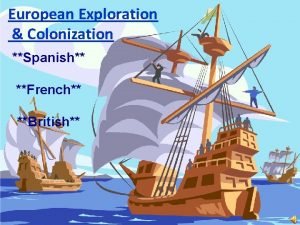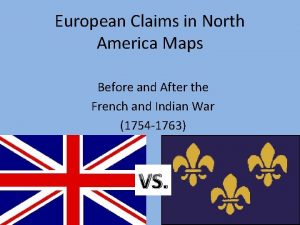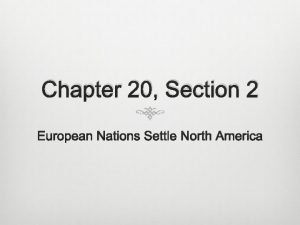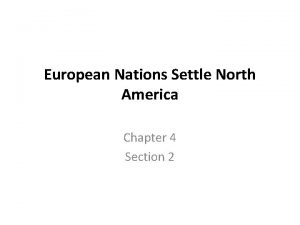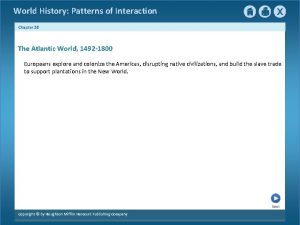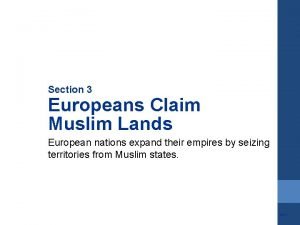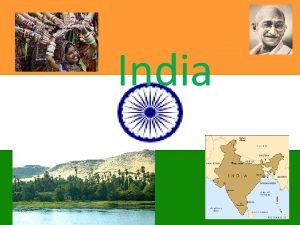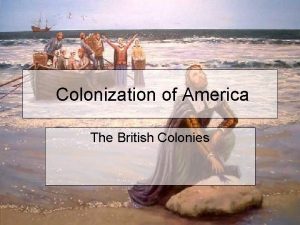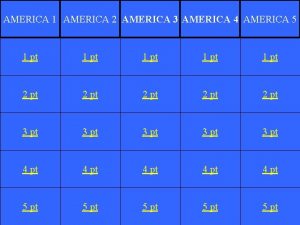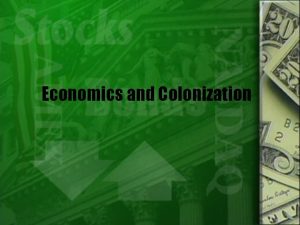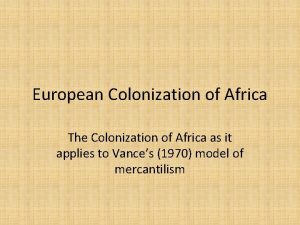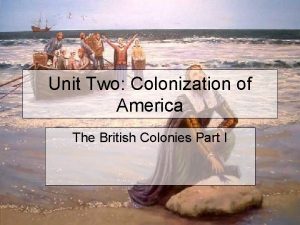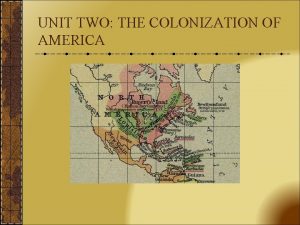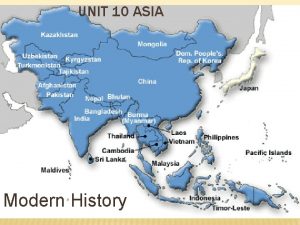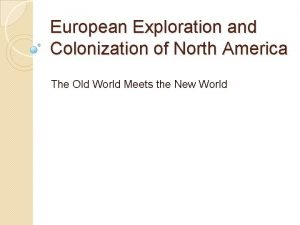Unit Two Colonization of America European Colonization of














- Slides: 14

Unit Two: Colonization of America European Colonization of America

Spanish Colonization • The colonization of what is America today started with the Spanish during the Siglo de Oro with many colonies (settlements in a new land controlled and ran by a parent country) all across the New World. • The largest area conquered and successfully colonized by Spain was the territory of the Aztec (Mexico) by Cortez, naming it New Spain. • The city of Tenochtitlan (Aztec capital) was burned to the ground and replaced with Mexico City as the capital of New Spain.

New Mexico • After the explorations of the Southwest of America, Juan de Onate in 1598 led a group of setters across the Rio Grande founding a new colony in the Southwest called New Mexico. • Pedro de Peralta became the first governor of New Mexico and made the town of Santa Fe its capital. • As a way of settling the different colonies and stretching their boundaries the Spanish founded strings of presidios (missionaries/forts) to house monks and soldiers to Christianize and civilize the natives. • The priests were either of the Dominican or Franciscan orders.

New Mexico • Starting in 1769 a Franciscan priest named Junipero Serra spread the Spanish empire into Alta California establishing presidios from San Diego to San Francisco which were linked together by the El Camino Real (Royal Highway). • In the colony of New Mexico a Pueblo named Pope in 1680 led a massive revolt known as the Pueblo revolt to expel the Spanish from the area.

The Spanish Empire • To control and coordinate all Spanish colonies in the New World and Asia the Council of the Indies was formed to oversee all the colonies. • In the colonies the lands were divided into haciendas (large estates) ran by a labor system called the encomienda system run by an encomendero. • The Natives were forced into servitude (slavery) to mine for gold, farm cash crops, or run ranches of cattle or pigs. (Indian cattle herders were called Vaqueros which were the first cowboys)

Colonial Society • In New Spain and other American colonies a new class system developed with the new emerging culture in the Americas. – 1. ) At the top were the Peninsulares who were born on the Iberian Peninsula, if they were of nobility they were called Hidalgos. – 2. ) In the middle were the Criollos who were born in the Americas, but pure blood Spanish. – 3. ) The lower class were the Mestizos who were mixed Spanish and Native. – 4. ) The lowest level of the society was true natives, Africans, or mixed African-Natives.

French Colonization • The French chose not to colonize the New World in large numbers, but rather use outposts for strategic military advantage and for the fur trade. • The first colony founded in America by the French was on the island of Acadia (Nova Scotia) in 1603 by Pierre Dugua de Monts with its capital being Port Royal. • In 1608 Samuel de Champlain founded the city of Quebec to be the capital of France’s second colony New France (Canada). The second major town in New France was Montreal.

New France • The French used New France as an outpost for the Fur trade in American beaver, deer, moose, and other animals. • The French skinned the animals for their pelts (skin) to make all sorts of clothing. • The French did not choose to enslave the natives, but rather chose to treat them as equals and learned their cultures. This allowed the French to create friendly relations with the natives and to gain the ability to hunt across the land without problems.

Louisiana • The colony of Louisiana was founded by Robert Cavelier de La Salle in 1682 which incorporated all the lands along the Mississippi River between the Spanish (West) and British (East). • In 1699 Pierre Le Moyne d’Iberville and his brother Jean-Baptiste Le Moyne de Bienville traveled along the Gulf of Mexico to rediscover the mouth of the Mississippi River. • They established the settlements of Fort Maurepas (Biloxi, Mississippi) and the first capital of Louisiana Fort Louis (first city of mobile) in 1702. • To colonize the area d’Iberville sent for a hundred women known as the “cassette girls”.

Fort Louis (Mobile) • The city of Mobile was later moved in 1711 to its present location. • Dauphin island (Massacre island) was used as a deep water port for Mobile.

New Orleans • In 1723 the new city of New Orleans founded by Jean-Baptiste Bienville became the new capital of Louisiana. • It was built in a crescent of the Mississippi River (basically a bowl) to “protect it from hurricanes and tidal waves, and was also an excellent natural port. • The founding part of the city was called the French Quarter.

Henry Hudson • The Dutch East India Trading Company in 1609 hired an English explorer Henry Hudson to find the Northwest Passage. • Hudson explored the east coast of America discovering the North River (Hudson river) and present day New York. • In 1610 -1611 Hudson sailed for the British and discovered what is Hudson Bay in Canada.

Dutch Colonization • The Dutch claimed the land found by Hudson and established the colony of New Netherlands or New Holland. • To protect their position the Dutch built Fort Orange (Albany, New York) in 1624 making it their first settlement. • In 1624 the Dutch purchased the Island of Manhattan from a couple of tribes of the Lenni. Lenape for trading goods ($24 dollars worth) founding the town of New Amsterdam as a center of trade for the Americas.

Swedish Colonization • In 1637 the Swedish empire (included Finland) wanted to create a cash crop economy in the New World, so they sent an expedition headed by Clas Fleming to explore the east coast of America. • Fleming sailed up Delaware Bay into the Delaware river founding the colony of New Sweden at Fort Christina (Wilmington, Delaware). • The Swedish built a new form of housing in America that became very important, the log cabin.
 Who colonized north america
Who colonized north america Early european exploration and colonization resulted in -
Early european exploration and colonization resulted in - After 1880 european nations sought
After 1880 european nations sought Colonization of south america
Colonization of south america Reasons for colonization in america
Reasons for colonization in america Unit 2: exploration and georgia colonization
Unit 2: exploration and georgia colonization Unit 1 exploration and colonization
Unit 1 exploration and colonization European colonies in north america
European colonies in north america European colonies in north america
European colonies in north america European land claims in north america map
European land claims in north america map European nations settle north america chapter 20 section 2
European nations settle north america chapter 20 section 2 European nations settle north america chapter 4 section 2
European nations settle north america chapter 4 section 2 Chapter 20 section 1 world history
Chapter 20 section 1 world history Chapter 20 section 2 european nations settle north america
Chapter 20 section 2 european nations settle north america Chapter 20 section 2 european nations settle north america
Chapter 20 section 2 european nations settle north america
